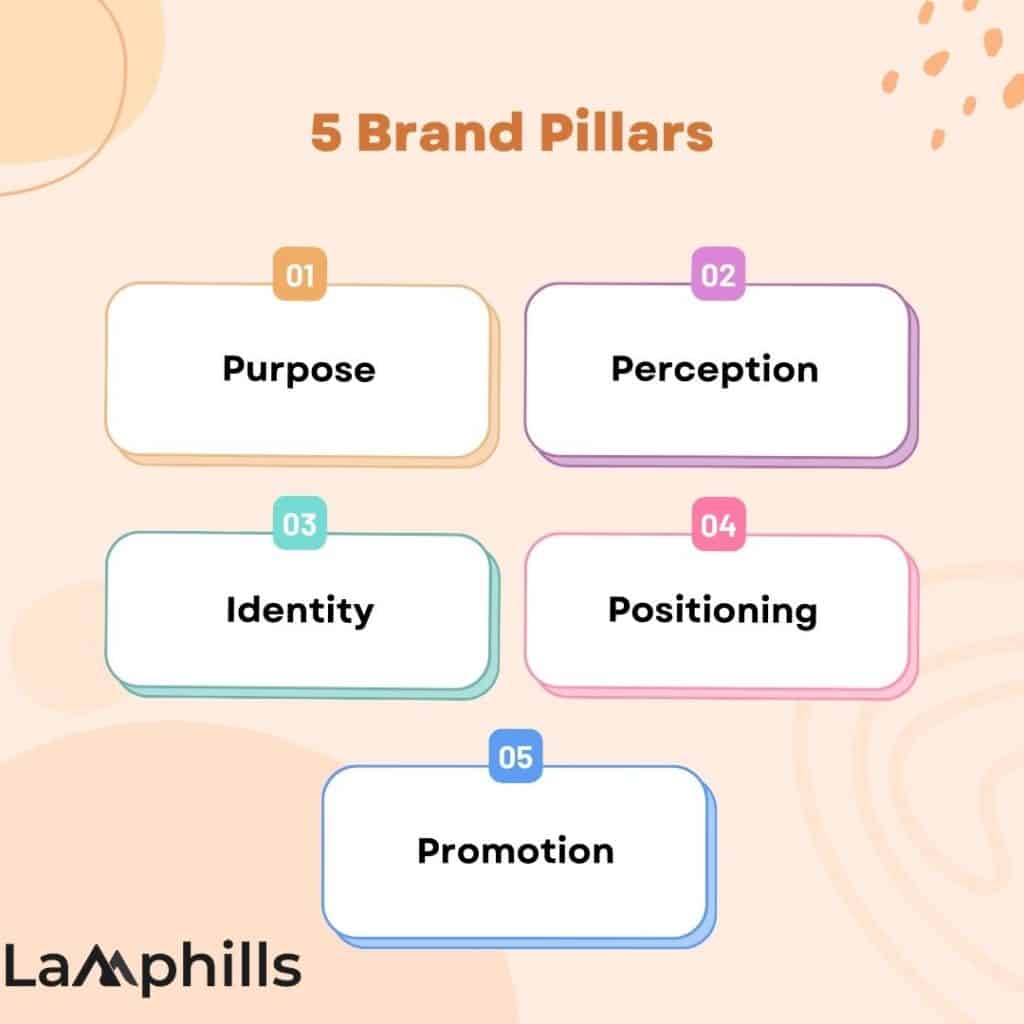Imagine walking into a store where everything is perfectly in order. Starting from the ambience, product quality, and customer service, everything aligns perfectly. This isn’t an accidental cause. It is as a result of a defined brand pillar. These foundational elements guide companies in creating a compelling brand identity that will not only attract customers but also retain them.
In this article, I will discuss the concept of a brand pillar, how to create your own brand pillar and some examples of some companies’ brand pillars.
What Is a Brand Pillar?
Brand pillars are classifications used by companies to define a brand and showcase its important values. When a brand uses these pillars effectively, it can help it differentiate its products and services from those of its competitors. Brand pillars help companies create equity, which is the customer’s perception of the brand’s value. Brand pillars work in collaboration with other business elements such as customer service, demographic targeting, and even the development of new products and services.
Brand pillars help you communicate your message to the world by defining the fundamental points that set your company apart from your competitors. Brand pillars can be your core values, important strengths, or aspects of a brand that support or add dimension to the core ideas of “Who are you?” and “What can you offer?”. These pillars should be strategic decisions to offer better products or services to your customers.
Key Points
- Brand pillars are classifications used by companies to define their brand and showcase its important values, helping to differentiate their products and services from competitors.
- The main brand pillars include purpose, perception, identity, positioning, and promotion, each contributing to the overall brand strategy and customer connection.
- Companies like Hilton, TikTok, and Nike effectively use brand pillars to communicate their values, identity, and customer experience, thus reinforcing their brand purpose and achieving business success.
Why Are Brand Pillars Important?
Having a strong brand is a point of connection for customers and helps businesses quickly communicate the essence of their vision and values. But branding trades in the currency of opinion, and fickle followers, making it subject to trends and many more. It’s just like the stronger the brand, the more likely it is to weather storms of change.
Brand pillars are the most important part of branding. The touchpoints that help a brand define its value are a step towards clearer communication. Each pillar breaks down the nuances of a new brand. This helps the public connect the brand to the products and services a business offers. It also helps customers, stakeholders, and investors understand what it means to support your company.
What Are the 5 Brand Pillars?

The main brand pillars include purpose, perception, value, identity and brand experience. Let’s break it down below
#1. Purpose
Before you start a brand, the first thing you ask yourself is, “Why am I starting this brand?” “What do I hope to achieve with this brand?” This is you trying to generate your purpose. The purpose is more like your aim—that thing you want to achieve with the brand. It refers to a brand’s origin, vision, values, and mission. It includes your goals, future goals, and long-standing values. To develop a company’s purpose pillar, consider sharing the history of why its founder started the brand and how the company’s mission may have changed over time.
Think about purpose as the answer to these questions. “What are your brand values? What is your brand story? Why does your business exist? What problem is the business hoping to solve and how does it intend to solve it? What do you want to communicate to your audience and employers? If you can answer these questions correctly, then you have understood the purpose of your brand or business. Knowing these purposes will help you hire employees who align with your mission and correctly target your audience.
The purpose of your business might seem obvious but making those purposes into a pillar is an effective way to clearly outline your business offering. Customers also like to have access to the brand’s story, which can create an alignment with their own values. Articulating the purpose of a business might help convey your goals to both customers and employers.
#2. Perception
Perception is just how your customers view your brand. You will want to check if your perception actually aligns with your purpose. Are your customers viewing your brand according to the purpose of the brand? Perception also covers how your team members feel about the company’s culture and work environment. A positive work environment attracts effective employees who commit to the company. This can promote job satisfaction, which may improve customers’ perception of the brand.
How do you want your customers to perceive your brand? What kind of language do people use to find solutions to the problem you are solving? What emotional response does your brand or service inspire? How does your service or brand compare to your competitors? The language you use to describe yourself, your logo, social media activity, product, and after-service support all contribute to your audience’s perception. It’s how a brand defines its identity and personality. It’s critical to manage the audience’s perception of your brand to maintain loyalty and build trust.
#3. Identity
What kind of voice do you have as a brand? Professional, playful, cheeky, bold, humorous, or straight-talking? What is your workplace culture like? What is your engagement on social media like? Who do you use as the face of your company in your marketing?
It’s just about who you are as a brand. Your brand is something that you are, not something you have. It’s all about your personality as a company. One thing with this identity, which I also call personality, is that it works hand in hand with perception.
To develop a company’s identity or personality, consider using surveys to collect customer feedback. This can help you improve the company’s brand marketing strategy and adjust the identifiers the company is promoting. You might create or update the company logo to form a visual identity for the brand. Typically, the logo reflects the brand identity, including colours and design. Some commonly used brand personalities include bold, cheeky, youthful, dynamic, creative, athletic, cutting-edge, sporty, etc.
#4. Positioning
Who is your target audience? And why do you think you can appeal to them? Who is your competition? What sets you apart from them? Who are you already appealing to? Is this your ideal market or could you improve?
We all have to start somewhere. Most businesses start at the bottom and work their way to the top with a good strategy. Let’s take Amazon as an example. The brand first started as an online bookshop. Amazon quickly established itself as the go-to destination online for second-hand books before extending to DVDs, games, and videos. They were competing with brick-and-mortar bookshops and other retail stores. But by building a position from that of a disruptive online bookshop to a general store, they have become the world’s most popular shopping mall. Amazon has stayed true to its identity and this has helped to increase their sales too.
Creating a brand position can help you target the right demographic for a company, which may improve sales. This positioning is simply your target audience and how your brand approaches them. Once you determine the target audience and what they are interested in, consider incorporating it into your marketing strategy.
#5. Promotion
How do you get your brand seen? Where are your customers looking for your competitors? How do customers engage with your industry? Do you have brand ambassadors and how do they present themselves? What kind of experience do you want your customers to have? To be honest, all it takes to create this promotion pillar is to answer these questions.
This pillar refers to how a brand uses advertising and marketing to create awareness and attract potential customers. Brand promotion involves a communication strategy to appeal to new and loyal customers. A typical brand promotion strategy includes advertising, messaging, and other communication strategies.
What you are thinking about here is how your brand interacts with potential customers in the real world and online. With all you have known from the four pillars, how can you ensure that you are in the front of your customer’s minds when it comes to a decision? Yes paid marketing features and having a search and social strategy, both paid and organic, are key here.
How Do You Create Brand Pillars?
The following step below is a breakdown of how to create your brand pillar.
#1. Refine Your Company’s Purpose
As your business gets off the ground, you need to decide what to focus on. It can be funding, overhead, or hiring. This can impact your ability to remember this initial driving purpose for your business. This purpose, most times, is the core of your business. When creating a brand pillar, it’s easy to write something that sounds good but doesn’t really mean anything.
As you think about the purpose of your company, also consider what your audience would do if your company didn’t exist. What will make your business impossible to replace? Is it your people? Is it your customer’s approach? Your quality assurance? There is always a purpose behind every decision you make in your company so before you draft your brand pillars, revisit and refine that purpose.
#2. Research to Understand How Customers See Your Brand
Whether you are creating this brand pillar as rebounding or you are making a new brand pillar, customer perception is always key. You can start with what your audience already knows about your brand to meet their high expectations. You can use social listening tools and reputation management tools to get a sense of how your audience feels about your brand.
The next thing to do is track your customer’s journeys, gather their feedback, or review them at each point. As you collect these data, think about the role you play in your customers’ minds and what they actually perceive your value to be. While it might be tempting to make guesses about how your customers feel and how they want to engage with your brand, it’s best to pair guesses with data. You may decide to make use of a customer profile template or create an ideal customer profile
#3. Develop Your Brand Identity
Your brand identity is a composite personality when it comes to brand pillars. It’s a mashup of the community you have built in your company and how those voices come together. It is something that shows how professional the different groups in your company are when they come together. But you can’t create a pillar with a fake identity; you need something authentic. You can’t just invent what you want your identity to look like or sound like. Your brand identity comes from the consistent voice of your brand, team, and product. One thing about this brand identity is that you can’t force it; it must come naturally to anything you are doing.
Defining your voice and brand is about strategizing how you want to speak to your audience on several platforms. The brand identity shows what the employees might be like, how they behave, and who your customers are.
#4. Define Your Company’s Value
When you ask yourself these questions, what’s important to you in your interaction with your audience? What do you value even above your own financial interests? This is the best way to define your company’s value. Your company’s value usually describes how your business wants to manage relationships and grow. They may directly connect to your brand pillars or they may inspire your pillar. A company’s value can help you take the purpose of your business from a vision to an active set of principles. So if your purpose is the end goal, your values are the path you want to take to achieve the goal as a team.
#5. Create a Powerful Brand Experience
Your brand can’t look nice or sound great If it doesn’t have a great brand experience,. Thousands of your customers make different decisions every day, and if you want to create a brand with influence, you need to come up with ways to impact those decisions. Your brand experience will define much of your perceived appearance, personality, and reputation. When you want to create your brand pillar, you should keep in mind what your customers can get from you. Is it high quality? Good customer care service? Timesaving services? Convenience?? What exactly is going to make it possible for you to impact their decision-making?
It may sound small or insignificant but choices like how long it takes to put on a pair of shoes or the texture of a noodle can make a difference in how your customers feel. If that brief feeling lasts, they will remember it the next time they are talking on the phone with a friend or scrolling through social media.
#6. Test Your Ideas
You are done with your ideas, right? Now is the time to test them. You may want to run a survey with your internal team or a selection of a group of customers. Focus groups or A/B testing are useful strategies too.
You may also want to run some competitive analysis to see whether your brand pillars measure up against others in your industry. A draft may sound good but not work out when it’s applied to a real-life situation. And a big idea can make business sense but not resonate with customers. So once you have drafted your brand’s pillars, verify your ideas. After early testing and launching, do regular testing to see if your brand perception needs an update to evolve with your customer needs.
#7. Adjust Your Brand Strategy to Meet Customer Needs
After collecting the customer data, the next thing is to put it to good use. You might be tempted to hold onto the pillar you already created but sometimes your company must change with your customers. Find ways to proactively communicate changes to your customers. Use your analytics to measure the channels and platforms where your brand pillars come into play. Then use those insights to balance customer expectations with business goals.
Here is a more concise and FREE checklist to make the process easygoing:
Brand Pillars.Pdf
What Are the Examples of Brand Pillars?
#1. Hilton
Hilton’s brand pillars are clearly written on its website. They value Hospitality, integrity, leadership, teamwork, ownership and a sense of urgency. These are their stated values, but they are really brand pillars. They showcase how the company wants its customers to perceive them, what its identity is, what the customer experience is like, and what they value.
#2. Tiktok
Tiktok’s identity is the expression of its users. It changes as their user base changes and its value lies in the creativity of the customers. Tiktok’s core brand page highlights its brand pillars with a voice that is as clear and quick as the platform experience. Their purpose is to help users discover more and to create the perception of a constant refresh for their users. These pillars support a brand experience of relentless energy that explains the meteoric growth of social media.
#3. Savage X Fenty
The brand pillars for Savage X Fenty highlighted on their About page are the foundation of the brand. With brand pillars of fearlessness, confidence, inclusion, accessibility, and individuality, it quickly communicates the core of its brand purpose, identity, and experience to a wide audience.
#4. Samsung
Samsung is a global corporation with a diverse technology product portfolio. This means that its brand pillars don’t just need to speak to B2C customers purchasing mobile phones and digital displays. It also needs to communicate its purpose, values, and identities to B2B customers in networks, health, and medical equipment.
To show commitment to the brand’s growth in technology, they have pillars like progressive innovation and defiant optimism. At the same time, pillars like integrity, transparency and social betterment put an emphasis on its values.
#5. Nike
Since the founding of Nike, it has been consistent in its brand pillars. They are all about competition and surpassing one’s limit. All the company’s advertising, messaging, and investment decisions support that personality and value.
What Are the Strategic Pillars?
Strategic pillars are the key areas of focus or priorities that an organisation chooses to achieve its long-term vision. They are also often called battlegrounds.
How Many Pillars Should a Business Have?
The technical answer to how many content pillars you should have is that it varies. In most cases, though, three to four pillars are the sweet spot. That is unless your business provides a large number of services. This number tends to work best because each pillar page takes time to plan, create, and maintain.
What Are the 7 Pillars of Personal Branding?
Jill Hauwiller, owner and principal consultant at Leadership Refinery, describes the framework she leads her coaching clients through—one that encompasses seven key components: Purpose, Values, Clarity, Strengths, Energy, Legacy, and Ownership. The purpose is to understand why you do what you do.
Conclusion
In conclusion, brand pillars are a useful way to share up your brand strategy. They can help you define and differentiate your company from the competition. And you can use brand pillars to build awareness and shape sentiment about your brand. Brand pillars are nice to have but not an essential component of a business. But by defining your brand pillars, you can find that it is easier to articulate your business vision to your customers, employees, and potential investors. It can be a useful way to define your business and keep you on track.
Related Articles
- Pillars of Omnichannel Management
- How To Create Great Content Pillars (With Examples)
- What is the Press? Understanding The Role Of The Press In the Society
- A Complete Guide to Building Niche Relevant Backlinks






